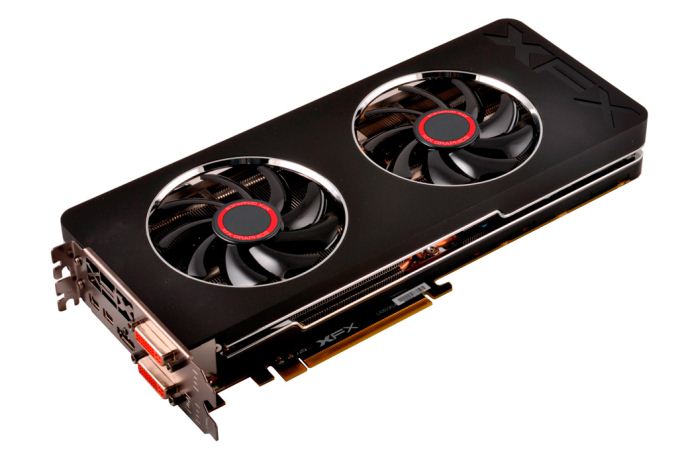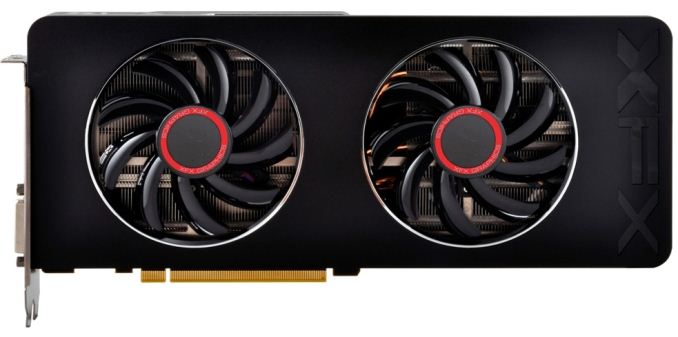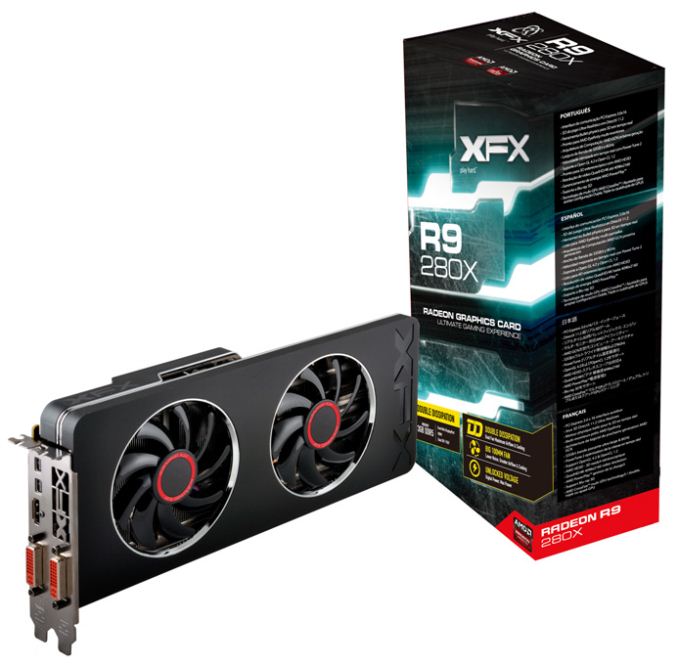The Radeon R9 280X Review: Feat. Asus & XFX - Meet The Radeon 200 Series
by Ryan Smith on October 8, 2013 12:01 AM ESTXFX Radeon R9 280X Double Dissipation
The first of our R9 280X cards is our reference-like sample, XFX’s Radeon R9 280X Double Dissipation. The R9 280X DD is XFX’s sole take on the 280X, utilizing a new and apparently significantly revised version of XFX’s Double Dissipation cooler, and paired with a 280X operating at the 280X’s reference clocks of 850MHz core, 1000MHz boost, and 6GHz RAM. Since there isn’t an overclock here, XFX will primarily be riding on their cooler, build quality, and other value add features.
Diving right into the design of the card, the R9 280X DD is a fairly traditional open air cooler design, as is common for cards in this power and price range. This basic design is very effective in moving large amounts of heat for relatively little noise, making the usual tradeoff of moving some of the cooling workload onto the system’s chassis (and its larger, slower fans) rather than doing the work entirely on its own.
In XFX’s case this is a new design, having forgone their older Double Dissipation design that we first saw on their 7970BEDD back in 2012. What’s changed? Without going into minute details, practically everything. At first glance you’re unlikely to even recognize this as an XFX card due to the fact that this is the first such product from XFX using this design, which aesthetically looks almost nothing like their old design.
First and foremost XFX has gone for the oversized cooler approach, something that’s become increasingly common as of late, equipping the card with one of the larger coolers we’ve ever seen. At 100mm in diameter the two fans on XFX’s design are among the biggest we’ve ever seen, pushing the card to just over 11.1 inches long while causing the heatsink and shroud to stand about 0.75” taller than the board itself.
Drilling down, XFX is using a two segment heatsink, the combined length of which runs the complete length of the card. Providing heat conduction between the GPU and the heatsink is a set of 6 copper heatpipes mounted into a copper base plate. 4 of these heatpipes run towords the rear of the card and the other 2 to the front, perpendicular to XFX’s vertical fin heatsink. Meanwhile cooling for the various discrete components on the board, including the memory, is provided by a separate cut-out baseplate that covers most of the card. There isn’t any kind of connection between the baseplate and the heatsink proper, so it’s the baseplate and any airflow over it that’s providing cooling for the MOSFETs it covers.
Moving on to XFX board, it looks like XFX isn’t doing anything particularly exotic here. XFX is using their standard Duratec high-end components, which includes using solid caps and chokes (typical for all cards in this power category) along with their IP-5X dust free fan. A quick component count has us counting 7 power phases, which would be the reference amount for a 280X, meaning we’re looking at 5 phases for the GPU, and another 2 phases for the memory and I/O.
Meanwhile for I/O XFX implements the common Radeon display I/O configuration of 2x DL-DVI, 1x HDMI, and 2x Mini DisplayPort 1.2. All the while external power delivery is provided by a set of 6pn + 8pin power connectors, as to be expected for a 250W card. With that in mind XFX’s design should have at least some overclocking headroom, but XFX doesn’t provide any overclocking software so you’ll need to stick with Catalyst Overdrive or 3rd party utilities such as MSI Afterburner.
Finally, as a Double Dissipation product the 280X DD is covered by XFX’s lifetime warranty policy, contingent on registering the card within 30 days of purchase. Interestingly XFX remains one of the few board partners that still offers any kind of lifetime warranty, making them fairly exceptional in that regard. As for pricing we’re listing the XFX card at $329 at the moment, though there is still some confusion over whether that’s the final price or not as our XFX rep seemed unsure of that. As is sometimes the case in this industry, we get the impression that they were waiting to see what other manufacturers were going to charge, in which case we suspect the actual launch price will be lower than that. We’ll update this article once we have final pricing information available.













151 Comments
View All Comments
Dribble - Tuesday, October 8, 2013 - link
Didn't you read the article - it is a 7970GE give or take a little on clocks (depending on what 280 you buy). The only new card is the 290 all the others are the same cards you could already buy. The news is lower prices, although as 7970's were already at lower prices then AMD recommended not sure how much real change there will be.The biggest downer for AMD fans will be the end of the 7950, which was always the price/performance king.
Da W - Tuesday, October 8, 2013 - link
It's gonna be the R9 280 (no X).I might just go and buy two 7950 right now. I'm not sure a single Hawaii priced near a 780 is worth it, crossfire issues notwithstanding.
Very disappointing. Specs I saw floating here and there pointed to 270X being more like a Tahiti XL.
zeock9 - Tuesday, October 8, 2013 - link
Didn't you read my comment - 7970GE can already be had for the same price, so it's the same card for more money because 280X doesn't come with the Never Settle bundle.Trying to charge more buck for less bang just because it has a new name is a effing shame of a business practice.
ninjaquick - Tuesday, October 8, 2013 - link
What do you expect? AMD is not releasing a new architecture this time around. They have a very efficient design in GCN, they will not go changing it. Mark my words, the 370X is going to be a die shrunk 7970 GHz, and the 460X is going to be the same, or just a 'rebadged' 370X. AMD's GCN is a bottom-up modular design, not a top-down big chip first design.HisDivineOrder - Tuesday, October 8, 2013 - link
Mantle is going to require they not stray too far from GCN and the way the cards are currently laid out. Otherwise, you'd have games suddenly having cards they're "Mantle compatible" with and cards they aren't.You won't see huge shifts in how the GCN is laid out post GCN 1.1 if they want to keep low level access working smoothly for the foreseeable future. Then again, perhaps they'll do the shift and just shift back to supporting their high level (drivers) instead once Mantle craters on impact because nVidia and Intel start throwing their money around...
Either way, I'm pretty sure Mantle is a cost-cutting tool to help de-emphasize driver development on the consumer side and help keep up with performance gains by aggressive nVidia and intel release cycles that AMD doesn't have the money to fight.
roastmeat - Tuesday, July 21, 2015 - link
Ha, well what do you knowThe 370 is a rebadge
chizow - Tuesday, October 8, 2013 - link
"AMD has been very explicit in not calling these rebadges, and technically they are correct, but all of these products should be very familiar to our regular readers."So how are these not rebadges/rebrands again and how is it technically correct to not call them rebadges? I just find it funny that AMD was so explicit about not calling them as such, I mean it's clear both parties have a history of rebranding, but let's call a spade a spade here.
Nvidia was pounded by AMD fanboys and the press alike for it's rebranding of G92, but any single iteration from G92 certainly had more changes than the non-existent changes we see with this R7/R9 rebrand stack.
Ryan Smith - Tuesday, October 8, 2013 - link
A rebadge would be something like the 5770 to 6770. Same card, same clocks, same TDP. These are new SKUs, based on existing GPUs, under a new name.chizow - Tuesday, October 8, 2013 - link
lol I guess we have some revisionist history that needs to be written then. Not blaming you of course for public perception, just saying, these were not the standards in G92's day as it easily cleared this very low standard of different clockspeeds/TDP/card design, as every single G92 incarnation surpassed these requirements.In any case, I did appreciate the in-depth coverage of Mantle, possible benefits, repercussions, downsides. Excellent coverage and commentary on all angles, as usual. Look forward to more detail about it in the future.
Gigaplex - Tuesday, October 8, 2013 - link
If the silicon isn't any different, the only distinction is in the board itself and the firmware setting the speeds etc, then it's a rebadge in my books. Nothing stopping OEMs from changing these around, and this does in fact happen with the OC cards. What is the difference between a rebadged chip with an OC vs one of these?